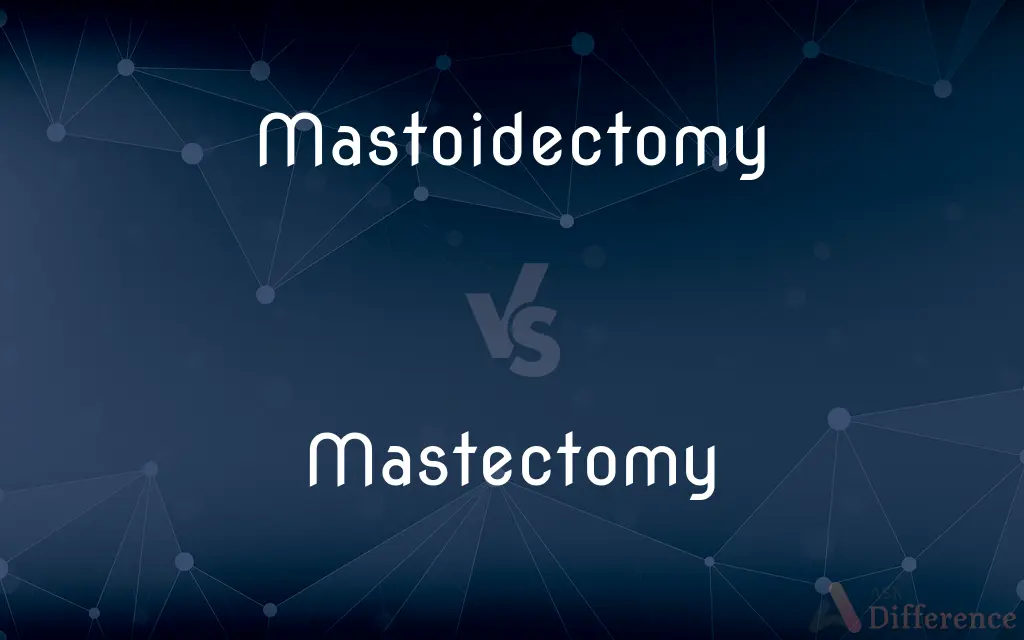Mastoidectomy vs. Mastectomy — What's the Difference?
By Fiza Rafique & Urooj Arif — Updated on April 27, 2024
A mastoidectomy involves removing infected mastoid air cells in the ear to treat infections, whereas a mastectomy entails the removal of breast tissue, typically to treat or prevent breast cancer.

Difference Between Mastoidectomy and Mastectomy
Table of Contents
ADVERTISEMENT
Key Differences
A mastoidectomy is a surgical procedure focused on the ear, specifically targeting the mastoid bone located behind the ear, which is part of the skull. Whereas, a mastectomy is performed on the breast and involves removing all or part of the breast tissue.
Mastoidectomy is primarily used to treat chronic ear infections and complications such as cholesteatoma, which can lead to hearing loss if untreated. On the other hand, a mastectomy is primarily used as a treatment or preventive measure against breast cancer, aiming to remove cancerous tissues or reduce cancer risk.
The technique of mastoidectomy can vary; it might involve creating a drainage pathway or removing infected bone to preserve the hearing mechanism. Conversely, mastectomy types vary from partial (removing part of the breast tissue) to total (removing all breast tissue), depending on the presence and extent of cancer.
Post-operative recovery for a mastoidectomy typically focuses on healing the ear and preventing further infections or complications, with follow-up care crucial for monitoring hearing. In contrast, mastectomy recovery often involves physical therapy to regain strength and mobility, as well as decisions about whether to undergo breast reconstruction.
While both surgeries are significant, the emotional and psychological impact of a mastectomy can be profound, often requiring support and counseling due to its impact on body image and personal identity. The mastoidectomy, while serious, typically does not have the same level of emotional and psychological impact.
ADVERTISEMENT
Comparison Chart
Purpose
To treat infections and complications in the ear
To treat or prevent breast cancer
Surgical Site
Mastoid bone behind the ear
Breast tissue
Common Reasons
Chronic ear infections, cholesteatoma
Breast cancer, high cancer risk
Procedure Variability
Drainage creation, bone removal
Partial, total, and radical removals
Emotional Impact
Generally limited to health concerns
Significant, includes body image and identity issues
Compare with Definitions
Mastoidectomy
A surgical procedure to remove infected air cells from the mastoid bone.
The patient underwent a mastoidectomy to treat persistent ear infections.
Mastectomy
Surgical removal of breast tissue, often due to cancer.
After her breast cancer diagnosis, she chose to have a mastectomy.
Mastoidectomy
Focuses on preserving hearing while removing infection.
The surgeon carefully preserved the hearing structures during the mastoidectomy.
Mastectomy
Associated with significant emotional recovery.
Support groups helped her cope with the emotional aftermath of the mastectomy.
Mastoidectomy
Performed to improve ear health and prevent hearing loss.
Mastoidectomy was necessary to stop the spread of infection to other areas.
Mastectomy
A preventive option for those at high genetic risk of breast cancer.
Due to her family history, she opted for a preventive mastectomy.
Mastoidectomy
Recovery involves ear care and monitoring.
Post-mastoidectomy, the patient regularly visited the doctor to check for infection recurrence.
Mastectomy
Can be partial or complete depending on cancer's extent.
She underwent a partial mastectomy to remove the tumor-affected area.
Mastoidectomy
Aimed at patients with chronic ear conditions.
Mastoidectomy is often recommended for patients with recurrent cholesteatoma.
Mastectomy
Often followed by breast reconstruction surgery.
Following her mastectomy, she discussed reconstruction options with her surgeon.
Mastoidectomy
A mastoidectomy is a procedure performed to remove the mastoid air cells, air bubbles in the skull, near the inner ears. This can be done as part of treatment for mastoiditis, chronic suppurative otitis media or cholesteatoma.
Mastectomy
Mastectomy is the medical term for the surgical removal of one or both breasts, partially or completely. A mastectomy is usually carried out to treat breast cancer.
Mastoidectomy
Surgical removal of mastoid cells or part or all of the mastoid process.
Mastectomy
Surgical removal of all or part of a breast, sometimes including excision of the underlying pectoral muscles, associated skin, and regional lymph nodes, usually performed as a treatment for cancer.
Mastoidectomy
(surgery) The surgical procedure to remove part or all of the mastoid process
Mastectomy
The surgical procedure to remove all or part of a breast and sometimes nearby tissues. Category:en:Amputation
Mastoidectomy
Surgical removal of some or all of the mastoid process
Mastectomy
Surgical removal of a breast to remove a malignant tumor
Common Curiosities
What are the types of mastectomy?
Types include partial, total, and radical mastectomy.
Who typically undergoes a mastectomy?
Individuals with breast cancer or a high risk of developing it may undergo a mastectomy.
Is hearing affected by a mastoidectomy?
The goal is to preserve hearing, but it can sometimes be impacted depending on the infection's severity and the surgery's extent.
Can a mastectomy be a preventive measure?
Yes, a mastectomy can be preventive for individuals with a very high risk of breast cancer.
What conditions warrant a mastoidectomy?
Chronic ear infections and cholesteatoma often require a mastoidectomy.
Are there alternatives to mastectomy for breast cancer?
Alternatives include lumpectomy and radiation, depending on the cancer stage and location.
What follow-up care is required after a mastectomy?
Follow-up includes physical therapy, regular screenings, and possibly reconstruction.
How do mastectomy types differ in terms of procedure?
They differ in the amount of tissue removed, from partial (lumpectomy) to total removal.
How long is the recovery from a mastoidectomy?
Recovery typically lasts a few weeks, but the patient must monitor for signs of infection.
How do patients cope after a mastectomy?
Many seek counseling and join support groups to cope with emotional and physical changes.
What should patients expect during mastoidectomy recovery?
Patients should expect some ear discomfort and a period of keeping the ear dry and clean.
What are common risks of a mastoidectomy?
Risks include hearing loss, dizziness, and facial nerve damage.
Are both procedures performed under general anesthesia?
Yes, both mastoidectomy and mastectomy are typically performed under general anesthesia to ensure patient comfort and safety.
What is the success rate of mastoidectomy?
Mastoidectomy has a high success rate in resolving infections and preventing complications.
Does insurance cover mastectomy and mastoidectomy?
Most health insurance plans cover both procedures when medically necessary.
Share Your Discovery

Previous Comparison
Beef vs. Biff
Next Comparison
Camaraderie vs. TeamworkAuthor Spotlight
Written by
Fiza RafiqueFiza Rafique is a skilled content writer at AskDifference.com, where she meticulously refines and enhances written pieces. Drawing from her vast editorial expertise, Fiza ensures clarity, accuracy, and precision in every article. Passionate about language, she continually seeks to elevate the quality of content for readers worldwide.
Co-written by
Urooj ArifUrooj is a skilled content writer at Ask Difference, known for her exceptional ability to simplify complex topics into engaging and informative content. With a passion for research and a flair for clear, concise writing, she consistently delivers articles that resonate with our diverse audience.
















































